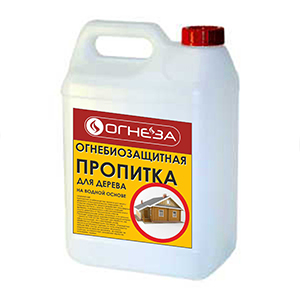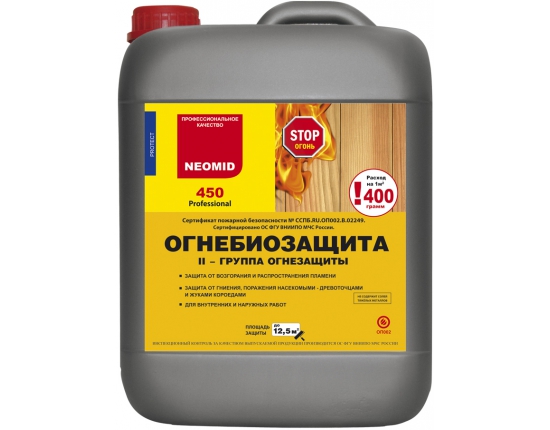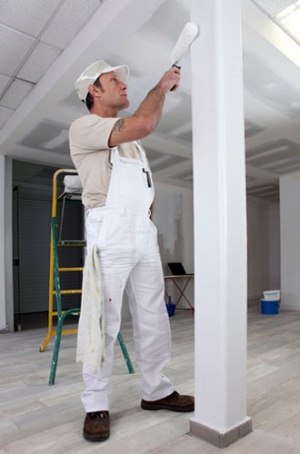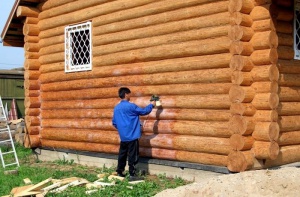Do-it-yourself fire protection of wooden structures: Choosing a fireproof impregnation. Fire retardant wood treatment.
Fire protection of wood
Taking care of the fire protection of wood is one of the mandatory stages of construction, given the flammability of wooden objects. Allow fire to reduce the flammability of wood protective compounds, the most demanded of which is fire retardant impregnation.
A wooden house is not only warm, environmentally friendly and beautiful. Wooden buildings have one significant disadvantage- they are highly flammable and burn quickly. To prevent this, special protective compounds are called upon. It is their choice that will be discussed.
Saunas and baths are buildings with increased fire hazard that need special fire protection. One cannot ignore the fact that high humidity air, mandatory for baths and saunas, negatively affects the wood, causing its deformation, contributing to the formation of mold, the appearance of fungi. Thus, fire retardants for such spaces must also provide a powerful antiseptic treatment. Finally, most steam rooms, baths and saunas can only be built of wood, and it is important to preserve its natural structure (for optimal air exchange) and appearance.
When choosing an impregnation, it should be borne in mind which of the sections of the wood structure to be processed. So, in places where the risk of fire is increased, first class impregnations should be used. As a rule, these are areas in contact with stoves, fireplaces, electrical wiring, as well as partitions, interfloor and roof ceilings. Impregnations of the first class of fire protection are usually means for deep processing. It is provided that the wood is soaked in baths with impregnating compounds, after which the material is dried.
Fire retardant impregnation of wood is one of the ways to protect it from fire, by treatment with a water-based or organic-based agent. The latter penetrates deeply into all layers of wood, without causing a change in its shape, but enveloping each fiber. Unlike organic, water-based impregnations provide surface protection, but they are easier to use and do not have a pungent odor.
Fire retardant impregnations for wood have been successfully used to protect against fire for many decades. Wood processing with special fire retardant impregnations is one of the most affordable and popular methods of passive fire protection among the people. wooden houses, cottages, baths and other buildings.
Wood is considered the most flammable material. It is highly flammable, fire spreads quickly through the tree, covering everything large area... At the same time, the wood is charred, which allows us to speak of a greater inertness of combustion of wooden structures with a large cross section.
Wood is one of the most demanded building materials, which is explained by the presence of a number of advantages (environmental friendliness, high strength and low thermal conductivity). However, wood needs high-quality fire protection, as it quickly ignites.
In order to create reliable protection all wooden parts from fire building structures must be treated with special compounds. Among them, three main groups can be clearly distinguished - impregnations, paints, varnishes. Fire retardants for wood - varieties and areas of application - allow you to secure a residential building, office space, manufacture building.
Bath according to all the rules: fire protection on high level... Most summer residents, and the owners of private cottages, together with the construction of a house, are planning to build their own bathhouse. A Russian bathhouse made of a log house is a traditional pleasure for body and soul. However, there is a "but" here: if you do not make fire protection, and according to all the canons, you will not have to enjoy a healing guy for a long time.
The summer season is in full swing, which means that many people use it in their dachas and in country houses baths and saunas. The question of a fire extinguishing system in a sauna is rarely put at the forefront; rather, the owner is worried about which stove to install, how to equip comfortable benches and create comfortable space for wellness procedures. However, numerous incidents of fire indicate that fire fighting system you need to think about it even at the design stage of the sauna.
Today, as well as many years ago, wood is very often used in construction. And the requirements for fire safety, especially for multi-storey construction, have become very toughened. Therefore, fire protection wooden structures and products is a very urgent problem.
Among construction and finishing materials there are many that pose varying degrees of danger. In order to maximize the safety of the room, you need to clearly distinguish between some aspects: environmental friendliness of the material, fire hazard of walls, resistance to fire. Of course, the aesthetic component is also important, but in this perspective it is not decisive.
Fabric is one of those surfaces in interior decoration that are considered fire hazardous. Fire protection in this case is important and necessary, this fact is beyond doubt. What are just the familiar phrases: “the fire has moved on to the curtains” or “the fire began to spread faster thanks to the carpets” ...
Fire protection of wooden structures. Everyone knows that wood in mandatory must be protected from fire, since it certainly belongs to highly flammable materials. In addition, it is the wood that contributes to the high speed of fire propagation, which significantly worsens the overall picture during a fire. However, all of the above factors are not a reason not to use a tree in various designs buildings, as well as in external decoration.
Fire protection methods: traditions and new trends. Each of the objects, regardless of its purpose, must go through several stages of fire protection. For this, various techniques are used, including the concreting of structures, and additional brickwork, the use of special materials for fire protection. Among fire retardants, the most common are coatings, special impregnations and varnishes.


Wood is light, beautiful, warm and practical material, but it is worth remembering about its flammability, which must be reduced when erecting wooden structures. If the wood is processed fire retardant coatings, then you can be sure that it will not burn out, and with a strong fire it will only smolder.
Fire retardant impregnations for wood will not become 100% fire and impact protection high temperatures but they are able to cope with accidental fires, for example, from a cigarette butt, a falling candle, a spark from a fireplace or stove that bounced off. In case of a strong fire, fire retardant impregnations will prevent the tree from immediately igniting, which will give an opportunity to gain time. It is worth taking care of the safety of the wooden structure in advance, for which it will be necessary to process them with special fire retardants, of which there are several types, different in composition and processing methods.
Composition of fire retardant impregnations for wood
There are 2 groups of fire retardant impregnations for wood:
Salt-based. The effect of such impregnations is simple - salt crystals do not allow the fire to spread, impregnations are applied deep enough and this must be done, according to GOST, before the construction of the structure. The advantages of saline solutions are obvious: inexpensive cost, high efficiency, but over time, salt crystals appear on the surface, which reduces the effect of protection.
Based on organic phosphorus. The action of the compositions is carried out on a molecular basis, that is, the impregnation substances bind to the components of the wood, as a result of which difficult-to-wash compounds are formed with a long-term perspective of action. In the event of exposure to open fire, impregnations begin to act in a complex manner - the combustion processes are suppressed, a "coke-coke coat" is formed on the surface of the wood, that is, the fire will not be able to spread over the entire surface of the tree.
2015-04-13 59 819Each building has high fire safety requirements. Before commissioning, the property must be checked by fire services for compliance with GOST and SNiP. Relatively recently, fire retardant treatment of wooden structures has become required from the owners of private houses.
The requirement for mandatory protection of structures made of wood from fire helps prevent the rapid spread of fire and is in compliance with PPB 01-03 p. 36. Fire retardant treatment wood structures with a fire retardant can be done independently in your home, but in apartment buildings and in crowded places, the task is assigned to specialized and licensed organizations.
Methods and means of wood fire protection
The term fire protection means comprehensive measures to reduce the flammability and fire hazard coefficient of wood and other materials and products. Fire protection treatment wood can include the following methods:- Cladding or trim wooden products using refractory materials.
- Structural changes and measures designed to increase the fire resistance.
- Fireproof fire retardant treatment of wooden structures using paintwork materials ( paints and varnishes).
Inspection of the condition and quality of fire-retardant processing of wooden structures is carried out by a representative of the Ministry of Emergency Situations. If necessary, you can order an independent examination of the object.
Fire retardant efficiency groups of wood
According to NPB 251-98, the effectiveness of fire protection of wood is characterized by the loss of mass of the wooden structure after its processing with paintwork materials. The test is carried out under realistic conditions. This makes it possible to see and predict the behavior of wood under fire conditions and to determine how effective the protection is.It is customary to distinguish between three classes of fire protection:
- 1 group of fire retardant efficiency of wood - maximum protection. In the fire test, the weight loss is only 9%. It is believed that processing according to the first class of fire resistance makes it possible to keep wooden structures from burning up to 150 minutes.
- Group 2 efficiency - weight loss during the test is 25%. Wood after treatment with compounds is hardly flammable. The second class of resistance is less effective than group 1. The fire resistance period is up to 90 minutes.
- Fire resistance group 3 - such a fire-retardant color of wood provides minimal protection. The third class treatment is mainly used for private houses with a low fire resistance coefficient.
There are at least four basic options fire retardant materials that can be used for industrial and private buildings, as well as commercial and entertainment centers... To process wood from fire as much as possible effective way it is necessary to know briefly about each of them.
Fireproofing impregnation for wood
Impregnation is one of the most common materials for fire protection of wood structures. There are two main varieties impregnating composition... Namely:In addition to the type of penetration of impregnations, it is necessary to take into account some more features associated with their purpose.
- Season. For open and unheated wood, you should choose a winter fire retardant for wood.
- Impact atmospheric factors... There is a hard-to-wash, indelible or easy-to-wash fire retardant coating for wood. The latter are easily washed off and lose their properties under the influence of moisture.
You can test the flame retardant treatment yourself. To do this, with different places wooden structures, a fence in the form of a chip is taken and set on fire with a match. The sliver should not burn without constant exposure to flame.
Fire retardant paint for wood
The principle of operation of fire retardant paint is somewhat different from how impregnation works. Antiseptic and fire protection wood from fire with paints is carried out by creating a layer of material that prevents heating and ignition. When a certain temperature is reached, the paint begins to release water and inert gas.Fireproof fire retardant paint wood for outdoor use effectively prevents wood from rotting. Paint is applied manually with rollers, or using a special pulverizer by airless spraying.
The frequency of processing wooden structures with a fire retardant composition depends on the selected paintwork materials, but according to the manufacturer's instructions, its effectiveness remains for at least 10 years.
According to the principle of operation, fire retardant paint for internal works can be of two types:
- - this paint belongs to the first group of effectiveness. During heating, the pores of the paint crack, gas and water begin to evolve, and at the same time the protective non-combustible layer expands. Depending on the selected paintwork material, the swelling thickness can increase from 10 to 40 times.
Wood belongs to the fire hazard class G3 (normally combustible materials), but with the help of intumescent paint, the class can be improved to G1 (slightly combustible), and G2 (moderately combustible). Fire-fighting antiseptic fire-retardant composition for wood of the 1st category of efficiency, allows assigning the class NG (non-combustible) to structures after processing. - Non-intumescent paint - the thermal insulation layer is present from the very beginning. The composition of non-intumescent paints and varnishes includes liquid glass and fire retardant fillers. The indicators and class of fire hazard of wood with the help of these means can be increased to G1, G2. Compositions depending on the manufacturer and technical characteristics can resist direct fire for up to 80-120 minutes.
With regard to the purpose of the paintwork materials, they can be divided into: wear-resistant fire-retardant facade paints and materials intended solely for interior decoration... The advantage of using is that paintwork materials are presented in a large colors and can be applied as a finishing coat. The duration of the fire retardant treatment is up to 20 years.
Fire retardant varnish for wood
This type of paintwork material is intended for decorative surface treatment. With the help of varnish, it is possible to increase the fire resistance of wood while preserving the natural structure and beautiful appearance.Fire-resistant varnishes are used not only for processing load-bearing structures and walls. Varnish is widely used for coating wooden floors, laminate, furniture, PVC and other building materials included in the G1-G3 group.
The main distinctive properties and the characteristics of varnishes are:
- The frequency of processing is 6 years, subject to exposure to atmospheric precipitation, indoors up to 10 years.
- Fireproof wood varnish can be applied over an already painted surface. An exception is made by structures treated with water dispersion compositions.
- Fire protection works are carried out at a temperature of at least +5 degrees. The time interval between each layer is 12 hours.
- Each subsequent layer of varnish increases the fire safety of the wood.
- LKM can be matte and semi-matte.
There is no need for additional antiseptic treatment when using varnish. Bio-fire protection with the use of these products corresponds in efficiency to non-blowing paints.
Fire retardant materials for wood
In addition to paintwork materials intended to increase fire resistance, structural methods of fire protection of wood, as well as materials used to create a refractory frame or screen, can be used. These include:- GVL - to achieve maximum efficiency, important condition is an additional processing special mortars of construction profiles. Non-combustible gypsum fiber boards limit the effect of thermal energy on load-bearing elements... The solution from GVL is used if the processing of wooden structures of buildings fire retardants is impossible for one reason or another.
- Roll fire protection for wood - the material is a foil insulation. Application of fire protection roll type on a tree is usually performed in hard-to-reach and unvisited rooms, closed attic and attic floors, etc.
- Constructive fire protection - for wooden buildings the use of special refractory belts is provided. The task of the belt is to stop the unimpeded spread of fire. With regard to belts, there is an urgent need to develop a safety design at an early stage of work. At the planning stage, methods and means of increasing fire protection are developed, taking into account the places of greatest fire hazard. Compiled routing, which describes in detail necessary measures processing and additional protection.
- Additional means of protection. Support and bearing structures it is possible according to regulatory requirements protect with a brick frame, or special plaster mix, which includes vermiculite. Reinforcement of the frame is mandatory.
What kind of fire protection to choose for a tree
When choosing the necessary protection for a tree, it is best to contact a specialist of a licensed company that has the right to carry out protective work... Additionally, you need to make sure that the company has an assigned code for processing wooden structures according to OKDP.After the appeal, it will be compiled detailed list requirements and standards for the fire protection of structures, as well as at the end of the work, an examination of the treatment was carried out.
You can also determine a suitable composition for fire protection yourself. To do this, you need to take into account the following points: 
The durability of the impregnation largely depends on its correct application to the surface. Even a high-quality composition applied with a brush and roller evaporates after 1-2 years of operation. Nice results are achieved by applying the material using the hot-cold bath method.
Fire protection equipment for wood
Equipment for the fire retardant treatment of wood structures includes several important tools that are selected depending on the fire protection used.
After applying the fire protection, an act of checking the state of the fire protection treatment is drawn up. A check is carried out in the presence of a representative of the Ministry of Emergencies or an independent expert.
The method of checking the processing of wooden structures consists in a visual inspection of structures, as well as in a selective examination individual elements on the thickness and integrity of the layer.
Samples are tested by fire. The latter are carried out using special sensors of the PNP-1 type.
Based on the results of the processing examination, a decision is made to put the object into operation and a corresponding permit is signed.
fire safety standards
state standards fire safety






